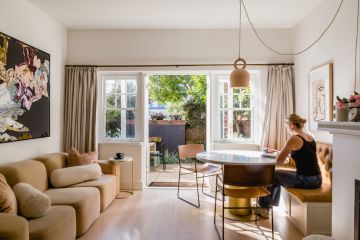Seven important tasks everyone forgets when selling their home

Selling your family home and moving to another can be one of the most chaotic times of your life, but being organised will streamline the process and help reduce the stress.
To make the sale run more smoothly, go through your house pretending to be an objective buyer and look for obvious faults which could be remedied, making sure these tasks are on your to-do list.
1. Deodorise the home
We all get used to the smell of our own houses to the point that we’re immune to distinct aromas. But when buyers are entering your home, you want to make sure the house gives a great first impression.
Air out the house to remove any stuffy air, and remove any cat litter trays, dog beds or anything else which may harbour pet odours.
If there is any mould, there is often a musty smell that lingers which makes the house seem unhealthy and neglected. Remove mould by spraying it with white vinegar then, using hot water and bicarbonate of soda, scrub the area and let dry. This should kill most of the mould, reducing the smell.
Home buyers may be put off by the lingering aromas of garlic-infused delicacies cooked up in your kitchen. Use hot soapy water to clean around the stove and oven, and around the rangehood.
Generally, ensure that all rubbish bins throughout the house are empty and clean.
2. Remove the junk
It is easy to hoard lots of unused, unnecessary junk if you have lots of storage such as a basement, attic or space under the house. Buyers may fear this clutter will be left behind for them to sort out, and this can be off-putting.
If you leave it behind, the buyer can force you to remove it, or pay for its removal. Instead, clear the clutter ahead of time to show off the ample storage your home offers. When it comes time to move, there will also be less to shift.
3. Know what you’re offering
Does the statue, pot plant or chandelier stay with the house, or are you entitled to take them with you? As a general rule of thumb, anything attached should stay behind and anything portable can be removed.
If there is any particular fixture you wish to keep, it can be included in your contract with a clause stating that it is not part of the offering.
4. Keep your private life private
Buyers want to imagine they could move into your house and feel at home. But decorating your mantles, dressing tables and walls with family photos makes them feel you are marking your territory. Pack photos away for the duration of the sale campaign and keep artwork neutral to appeal to a broad spectrum of buyers.
5. Lock away your valuables
Although Aunt Minnie’s sterling silver goblet looks ever-so-amazing on the sideboard, it is a valuable and very portable item which could easily be nicked at the next open home, and most likely won’t be the feature which creates a huge increase to the sale price for your house.
Unfortunately, thieves use open houses to scout for valuables, so be a jump ahead and remove and lock away from view anything that would tempt them.
6. Hide the negatives
Many houses have problems, so why bring them to the attention of a prospective buyer?
Nowhere to store the vacuum cleaner? Put it in the car during open houses. Lack of kitchen counter space? Remove the kettle, microwave or toaster to give the appearance of ample workspace. Small rooms? Remove bulky furniture and replace with smaller pieces.
7. Eliminate the pests
There is nothing that turns a buyer off more than a house crawling with ants or cockroaches or riddled with rat droppings. Fortunately, these deterrents can be easily fixed.
Remove any evidence of bugs and clean kitchen cupboards inside and out. If the pests persist, it may be time to spray, set traps or even use poison, or call in the professionals. Ensure your house is pest-free and ready to grab the imagination of the next prospective buyer.
We recommend
We thought you might like
States
Capital Cities
Capital Cities - Rentals
Popular Areas
Allhomes
More







